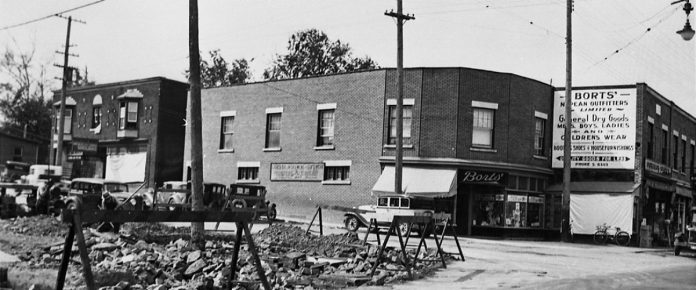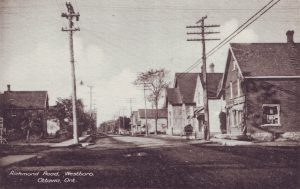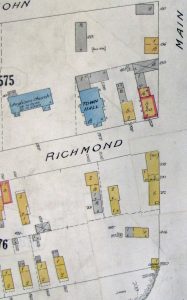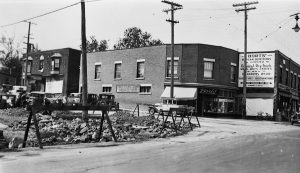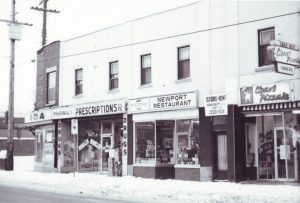By Dave Allston –
The iconic Lululemon building in the heart of Westboro, on the village’s busiest corner, turns 100 years old in 2019. This building has housed important shops, restaurants, medical offices and even homes that have been integral to life in Westboro. There are a century’s worth of great community memories found here.
John Ullett of the prominent Woodroffe pioneer family constructed the oldest portion of the building in 1919 on a lot he acquired through foreclosure on a mortgage he had given to the previous owner. The lot was wide; fronting 106 feet onto Richmond Road. At the time, the lot contained only a small, primitive wood house on the western edge, about where Lexington Smokehouse and Bar exists today. The rest of the lot sat empty and was fairly thickly treed. This wood house – built in 1898 by 31-year-old jeweller Benjamin Read Whiteley – was actually one of the first structures on the south side of Richmond Road, which until 1906 was the Highland Park Dairy Farm run by the Cole family. (It was the first farm in Canada to use electricity!) The Nepean Township town hall was built in Westboro in 1896 and when the streetcars arrived in 1900 it turned Westboro from farmland to a thriving village almost overnight.
Ullett’s building may have originally looked similar to one he had built four years earlier (in 1915) at the northwest corner of Richmond and Woodroffe (the old corner store that stood until just a few years ago).
The first tenant was one of Westboro’s most prominent citizens, and its first Jewish resident, Mr. Benjamin Bodnoff. The 32-year-old was a widower who had spent his twenties in the western neighbourhoods of Ottawa working his way up from nothing. He operated small shops that he also resided in, and in one documented instance, a building that had been condemned as uninhabitable.
In Westboro, Bodnoff operated a dry goods and clothing shop in the long, narrow one-storey commercial building that fronted busy Richmond Road. His determination and drive for success was nothing short of epic.
In March 1923, Bodnoff purchased the property from Ullett. The following year, he demolished the Whiteley house and constructed a massive $3,500 addition along the west side that filled the lot. It featured Bodnoff’s store, a Dominion grocery, Turner Brothers butchers, and the offices of lawyer W. E. Haughton and dentist W. M. Myles.
During this time, Morris Feldberg built the adjoining brick building to the south on Churchill Avenue (now Equator Coffee) for his shoe-making business. In fact, you can still see his “M” and “F” initials installed between the upper windows of the front of the building. He later opened Morris Formalwear in Hintonburg.
[Click photos to enlarge and view captions.]
Bodnoff’s continued to flourish through the roaring twenties and he reinvested constantly in Westboro. Between 1929 and 1930, Bodnoff renovated the portion of the store alongside Churchill, making it larger and creating the unique rounded corner that remains an instantly recognizable landmark to this day. He also strategically built the front of this portion of the building set 14 feet back from Richmond Road, in anticipation of the required widening of the road. As Ottawa and Westboro grew and cars replaced horse and buggy, the Richmond Road streetscape was simply too narrow. Over nearly 10 years, and at a massive cost, Richmond was widened to 66 feet from Western Avenue to McKellar Park. These costs included the expropriation of property, the demolishing and moving of many homes and buildings along the way, and the resurfacing of Richmond Road.
The rest of Bodnoff’s building originally did reach 14 feet further out to Richmond Road (over what would be the sidewalk today). This is best seen in the 1935 photo of the building (above), which shows the setback of the corner portion from the rest of the front (allowing for a great advertising space on the doomed front wall that was sliced off in 1939).
Bodnoff found his true passion in real estate rather than as a merchant. The early days of the depression also made business difficult, so he closed his store in May 1930 and put all his efforts into property acquisition and development.
In 1930, he acquired the two adjoining lots to the west, giving him nearly 240 feet of frontage, about to where Essentia is located today. An 1898 house built by former Hintonburg hotel-keeper, Andrew Cowan, (where Fooshin now stands), was converted to the Ideal Bakery in the 1920s. Bodnoff retained this house and built around it, constructing a large brick commercial building that originally housed Stevenson’s Hardware and for many years an A&P Grocers, but most notably, the second floor housed the Westboro Bowling Alley operated by William Seed. This building (and the Ideal Bakery house) were replaced in 1958 with the new Queensboro Building built by Freedman Realty, which still stands today.
Bodnoff purchased and developed several other Westboro properties while he was also significantly involved in local politics and charity work. He spent the remainder of his life in Westboro, moving from the upstairs portion of his building to a house at 472 Churchill in 1941, where he lived until his death in 1960 at age 72. It’s a remarkable success story for a Russian-born Jewish man who came to Canada as a teen with little money.
As for the Lululemon building, long-time Westboro residents may remember this store as being Bort’s Nepean Outfitters from 1930 to 1955, then Males Ltd. menswear from 1955 to 1964, at which time Carver & Ward expanded and doubled their floor space (they had been operating next door since 1951, in the former Dominion grocery store which had operated from 1926). In 1974, Carver and Ward sold, and it became the Westboro IDA Pharmacy, and later a Pharmasave until Lululemon moved in June 2004.
Next to this business in what is now freshii has almost always been a restaurant. Snider’s Lunch opened in 1933, replaced by Baird’s Lunch (1935 to 1943) and most famously, Port’s Lunch (1932 to 1973). When Port’s closed in 1973, the Newport restaurant’s first iteration opened in this location, until it moved to the other side of Churchill in 1979. At the west end of the building, in what is now Lexington, was a long-time butcher shop operated by George Turner (1925 to 1956), a television sales shop when TV first arrived in Ottawa, Rothman’s TV Centre (1956 to 1959), Cicero’s Pizzeria (1969 to 1981) and Puzzle’s tavern (1982 to 2009). There have always been apartments on the second level, and notably one man in particular, Marcus Goldenberg, lived there for 47 years (1934 to 1981).
It’s a much-loved building that continues to stand as part of the enduring legacy of early Westboro visionaries like Benjamin Bodnoff.
Dave Allston is a local historian and author of The Kitchissippi Museum. His family has lived in Kitchissippi for six generations. Do you have stories to share about the area? We’d love to hear them! Send your email to stories@kitchissippi.com. To read more of Dave’s columns, click here.
* This feature is sponsored in part by Lorenzo Bar and Grill.
